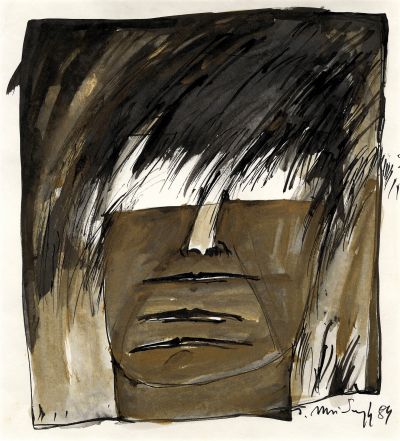Janina Musiałczyk. W drodze, on the road
Mediathek Sorted




































































































Images showing the deep emotional impact of events, memories and dreams
Musiałczyk developed her style of painting and drawing during a time in which new forms of figurative art and realism were becoming established in the US and Europe in numerous different manifestations. From the mid-1950s, or at the latest from the start of the 1960s, artists inspired primarily by Jean Dubuffet began to develop narrative, figural forms as a counter-reaction to abstract Expressionism and Informalism. Following an exhibition entitled New Images of Man 1959 at the Museum of Modern Art in New York, which showed works by Francis Bacon, Dubuffet, Alberto Giacometti, Leon Golub, Willem de Kooning, Nathan Oliveira, Germaine Richier and others,[35] the book “New Figuration” by the German painter and art writer Hans Platschek, which appeared that same year, and the term “Nouvelle figuration” coined in 1961 by the French writer and art critic Michel Ragon, described a figurative art which had existential human conditions, subjective fears, social isolation, cruelties, pessimism and catastrophes as its theme, and which was ultimately seen to be linked to the social and political turbulence that emerged during the Cold War.
Formal simplification and deformation of the figure, spasmodic, sweeping gestures, its confrontation with symbols, sombre colours or strong colour contrasts where characteristic of the style. The subjects of the works fluctuated between illusion and reality, and drew on Munch, Surrealism and, in a way closely related to Dubuffet, on children’s drawings and Outsider Art (art brut) for inspiration. This was followed by the development in the US of Pop Art and Photorealism, and in Belgium, the Netherlands and Denmark with the colourful-expressive COBRA group, the Zebra group in West Germany, a New, or Critical Realism, and the Fantastic Realism with national elements in Austria and West Germany, which was a further development of Surrealism.
In Poland, a new form of 1920s Constructivism was created after the war, which developed into a strong national tradition that would last for decades. Socialist Realism, which was prescribed by the state in 1949, was opposed by the playwright and painter Tadeusz Kantor and by Władysław Strzemiński, who began by painting Constructivist works before turning to two-dimensional abstraction from 1928 onwards. Socialist Realism was officially abandoned in 1955. Travel to western Europe and the US enabled Polish artists to forge connections to the international avant-garde. As a result, New Figuration was able to find a foothold in Poland as “Nowa figuracja”. Kantor drew ordinary people from the street in situations fraught with tension.[36] Władysław Hasior created a “Group Portrait” from different materials, in the shape of a huge, black scarecrow.[37] Influenced by Bacon and Ronald B. Kitaj, Janusz Przybylski painted figures trapped in social roles and existential hardships.[38] From the time of his participation in the 1970 Polska figuracja, polski styl, polska egzotyka exhibition at the Galeria MDM in Warsaw, Antoni Fałat depicted mostly blackened individual and group portraits in dramatically distorted situations which filled the entire frame.[39]
[35] Peter Selz: New Images of Man, exhibition catalogue, The Museum of Modern Art, New York 1959.
[36] Tadeusz Kantor: “Hanged Man” (Człowiek zawieszony), 1960; “Children in a Waste Cart” (Dzieci w wózku na śmieci), 1961; “Newspaper Boy” (Chłopiec z gazetami), series, 1968; all Łódź Museum of Art (Muzeum Sztuki w Łodzi).
[37] Władysław Hasior: “Group Portrait” (Portret zbiorowy), 1960s, assemblage, 135 x 200 cm, Łódź Museum of Art (Muzeum Sztuki w Łodzi).
[38] Janusz Przybylski: “By a Closed Door” (Przy zamkniętych drzwiach), 1971, oil on canvas, 190 x 110 cm (part of a triptych), National Museum in Wrocław (Muzeum Narodowego we Wrocławiu).
[39] Antoni Fałat: “Cyclist” (Cyklista), 1975, acrylic on canvas, 110 x 90 cm, National Museum in Warsaw (Muzeum Narodowe w Warszawie).





















































































